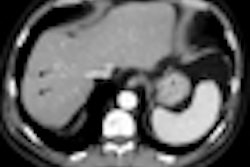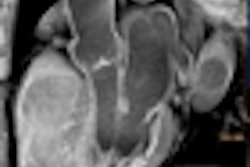A group of Pennsylvania researchers has developed a software program that quantifies characteristics of lymph nodes in the mediastinum based on MDCT data. The researchers believe the software could eventually help stage lung cancer, according to a study presented at last week's American Thoracic Society (ATS) meeting in San Diego.
Multidetector-row CT scanners give radiologists powerful tools for diagnosing lung disease, and assessing lymph nodes in the central chest can help stage lung cancer. But little is known about the quantitative characteristics of the nodes, according to William Higgins, Ph.D., a professor of electrical engineering at Pennsylvania State University.
To quantify lymph node characteristics, the researchers developed software that extracts the 3D airway tree, airway centerlines, major vasculature, and other structures and defines 3D regions corresponding to the 14 stations in the regional lymph node classification system by Mountain et al. They tested the software by performing MDCT scans on 32 lung cancer patients; the researchers did not have a group of healthy controls.
The group used 0.5-mm slice spacing, 0.75-mm slice thickness, and axial resolution of 0.52 mm to 0.92 mm. The majority of the scans, 19, did not utilize contrast, whereas 13 did.
"The contrast didn't help, and it can impair detection of the lymph nodes," Higgins said. "It had no effect on the shape or intensity."
Using the software, the researchers were able to identify 852 node stations in the 32 patients. The software found eight nodes in station M4 and four nodes in station M3, while stations M8, M9, and M12-14 had the fewest numbers of nodes (one in each station).
The software also quantified the x-ray attenuation of lymph nodes: For contrast studies, nodes registered 41 ± 35 HU, and noncontrast exams registered 17 ± 38 HU. In terms of node size, the software recorded node minor-axis length for all scans of 5.3 ± 3.0 mm and major-axis length of 13.1 ± 8.3 mm. This produced a minor/major axis ratio of 2.2 ± 0.8 (1 = node is a sphere).
A radiologist, pulmonologist, and skilled technician reviewed the software's work and deemed the results to be 90% accurate.
Higgins said that the results are intriguing from a pure science perspective, but the software but still needs tweaking to be useful in medical practice.
Dr. Rex Yung, a pulmonologist at the Sidney Kimmel Comprehensive Cancer Center at Johns Hopkins University in Baltimore, said the information has the potential to be useful if it is more focused -- and focused on gathering information central to staging.
"It doesn't matter where the node is, it matters where the tumor is," he said.
Having accurate 3D models of the airways and node locations can be particularly useful during bronchoscopy, where doctors are gathering tissue samples from tricky locations, Yung said.
Yung suggested that the important nodes -- 4, 7, 8, 10, and 11 in the Mountain system -- would be the most important to be able to model.
"With central mediastinum masses this could be very useful, especially if we go for the utility of real-time diagnostic applications," he said. "I think the vascularity and homogeneity of the node are the more important features."
Like most technologies, the quality of the output is tied to the skill of the people using the technology. Using the 3D software to locate and evaluate nodes taught the users about what they looked at on old scans.
"New technology always makes you better at reading the old technology," Yung said.
By Marty Graham
AuntMinnie.com contributing writer
May 27, 2009
Related Reading
CAD can perform well in subsolid pulmonary nodules found with CT, May 15, 2009
Computer-aided system increases detection of early-stage lung cancer, May 4, 2009
Integrating lung CAD with PACS boosts utilization, March 6, 2009
CAD helps novice readers detect pulmonary embolism in CT studies, February 12, 2009
Lung CAD shows promise as concurrent reader, January 30, 2009
Copyright © 2009 AuntMinnie.com




















